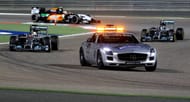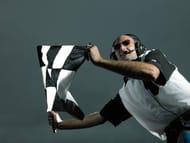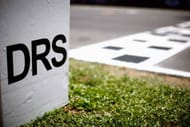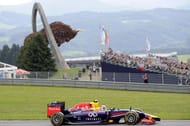The Austrian Grand Prix begins today at the Red Bull Ring in Spielberg, Austria, with qualifying today and race day tomorrow. The track is known for being high-altitude and rainy! Prior to qualifying this evening, the 20th of June, here are some Formula One terms you may want to familiarise yourself with:
#1 Safety Cars

These are especially relevant to the Austrian Grand Prix, which is held on a mountainous track and prone to rain. You may have seen a ‘regular’ looking car with flashing safety lights mounted atop – this is the safety car. Brought out either after an accident, or in inclement weather, safety cars are introduced when, as the name suggests, racing conditions become dangerous to drivers. The race director and marshals announce a ‘safety car’ period, and the car enters the track.
In addition to flags being waved, flashing LED lights installed in the cockpit of each car also indicate the presence of the safety car.
A safety car will have two sets of lights mounted on a bar on the roof, green and yellow. The yellow are standard, while green lights indicate that drivers are free to overtake the safety car.
Whilst the safety car is deployed, drivers must stay in formation behind it – no overtaking is permitted, and cars must maintain speeds. When the safety car is ending its run, lights will be flashed to indicate it is entering the pit lane. At this point, green flags are waved and lights flashed to tell drivers they may race again. Till then, the safety car will lead the pack of racers, followed immediately by the race leader.
German racing driver Bernd Maylander, who earlier in his career participated in the 24 Hours of Le Mans, has been the safety car driver for the past 15 years.
Several car makers have provided safety cars over the course of the history of Formula One – among them are Opel, Fiat and Lamborghini. However, since 1996, Mercedes have been the official supplier for the safety car, which this year are modified versions of the A C63 Estate and the AMG GT-S.
#2 Flags
You’ve probably seen marshals waving flags during the race. Everyone is familiar with the chequered flag at the end – but what about all of the other flags? Here’s a lowdown:

Chequered flags: everyone knows these. They signal the end of the race, waved at the winner and all subsequent cars when they cross the finish line.
Red flags: These are quite intuitive, indicating the stoppage or end of the racing session. This is usually done due to impossible racing conditions or if an accident has occured on the track.
Yellow flags: These, as mentioned earlier, are usually brought out to indicate safety cars, and to tell drivers to slow down. Overtaking is prohibited, and if two yellow flags are waved at once, this means cars must slow down, or potentially come to a halt.
Green flags: Brought out after yellow flags, when restrictions on speed and/or overtaking which were imposed by those flags are stopped. The race may now continue as before.
Yellow and red striped flag: This is to warn of a slick, slippery surface. Usually brought out in rainy conditions, or if there is oil spillage on the track. May be spotted at the Red Bull Ring!
Blue flags: To warn a driver that he is about to be lapped by another car, telling him to give way. A failure to comply with these flags three times in a row will cause the driver to receive a penalty. They are also waved when a car is about to enter the pit lane.
Half-white, half-black: Warns against what the FIA describes as “unsporting” behaviour, this flag is always displayed with a specific car number. Failure to comply may lead to a black flag.
Black flag: Used to tell a driver that he may no longer continue in the race. Like the half-white half-black flag, this is also accompanied by the relevant driver’s car number.
#3 D.R.S

And no, there’s absolutely no relation to cricket! DRS in Formula One stands for Drag Reduction System.
It is an overtaking aid for drivers. According to regulation, if a driver is within one second of another and within a DRS designated zone, he may activate the DRS, which alters the angle of the rear wing flap, providing the car an aerodynamic boost. These zones are indicated by markers on the track.
A DRS activated zone in a high speed sector of the track will give drivers an added advantage on the narrow straights at the Red Bull Ring, where two of the four straights are DRS activated.
#4 2 hour rule

FIA regulations stipulate both distance and time rules for Formula One races. The least number of laps required to cover a total distance of 305 kilometres is the length of each race, and this is proportionally adjusted for every race due to significantly varying circuit lengths.
The only exception to this rule is Monaco, where drivers must complete a proportional number of laps covering a distance of 260 kilometres.
In addition, there is a maximum time limit of two hours for any Formula One race.
#5 The points

The first three drivers make the podium – but the top 10 finishers are all awarded points:
